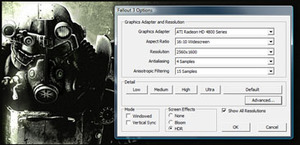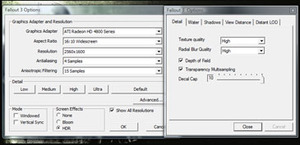XFX ATI Radeon HD 5830 1GB Review
Written by Harry Butler
March 22, 2010 | 11:08
Tags: #avp #hd-5830 #hd5830 #radeon #radeon-hd-5830
Companies: #xfx

Fallout 3
Publisher: BethesdaFallout 3 is the revival of Interplay’s excellent Fallout series of games following many years out of the limelight. It’s developed and published by Bethesda and, judging by the success of the game, we’ll be seeing more Fallout games in the future.
Despite using the Oblivion engine which is now a few years old, the game looks absolutely stunning. Bethesda has spiced up the graphics a bit since Oblivion and has extended the engine – there are some great explosions, soft shadows and smoke effects that are particularly noteworthy.
We tested the game by manually playing a section of the game that incorporates a number of explosions and effects that you’re likely to experience during your time in post-apocalyptic Washington DC. We recorded the frame rate using FRAPS.
The in-game details were set to their highest values and both anti-aliasing and anisotropic filtering were controlled by the application settings instead of through the driver control panel. This meant that transparency anti-aliasing was enabled, along with HDR and all of the cool smoke effects.
Fallout 3’s engine is by default capped to 60 frames per second, which can make benchmark results very unclear, especially when testing at lower resolutions or with high end graphics cards. To remove the 60FPS cap you’ll need to find the Fallout3.ini file in \Documents\My Games\Fallout3 and edit the file so that iPresentInterval=0. This removes the frame rate cap, and allows us to get a much better idea of a card’s true abilities.
Even then, recent cards and driver optimisations have started to push Fallout 3's engine to the limit, and the majority of cards on test will be limited by our test system's 3.2GHz quad core CPU at lower resolutions.
All graphs are ranked by minimum rather than average frame rates, as we feel that this is a more important metric when deciding if a card delivers smooth, playable performance.
Fallout 3
1,680 x 1,050 0xAA 16xAF, Maximum Detail
- ATI Radeon HD 5870 1GB
- ATI Radeon HD 4890 1GB
- ATI Radeon HD 5850 1GB
- XFX ATI Radeon HD 5830 1GB
- ATI Radeon HD 5830 1GB
- Nvidia GeForce GTX 285 1GB
- ATI Radeon HD 5770 1GB
- Nvidia GeForce GTX 260-216 896MB
-
-
82.0
-
50.0
-
-
-
82.0
-
50.0
-
-
-
82.0
-
50.0
-
-
-
80.0
-
48.0
-
-
-
80.0
-
48.0
-
-
-
80.0
-
47.0
-
-
-
77.0
-
44.0
-
-
-
72.0
-
41.0
-
0
10
20
30
40
50
60
70
80
90
Frames Per Second
-
Average
-
Minimum
Fallout 3
1,680 x 1,050 4xAA 16xAF, Maximum Detail
- ATI Radeon HD 5870 1GB
- ATI Radeon HD 4890 1GB
- ATI Radeon HD 5850 1GB
- XFX ATI Radeon HD 5830 1GB
- ATI Radeon HD 5830 1GB
- ATI Radeon HD 5770 1GB
- Nvidia GeForce GTX 285 1GB
- Nvidia GeForce GTX 260-216 896MB
-
-
82.0
-
47.0
-
-
-
81.0
-
46.0
-
-
-
70.0
-
42.0
-
-
-
74.0
-
34.0
-
-
-
74.0
-
34.0
-
-
-
67.0
-
30.0
-
-
-
76.0
-
28.0
-
-
-
68.0
-
18.0
-
0
10
20
30
40
50
60
70
80
90
Frames Per Second
-
Average
-
Minimum
Fallout 3
1,920 x 1,200 0xAA 16xAF, Maximum Detail
- ATI Radeon HD 5870 1GB
- ATI Radeon HD 5850 1GB
- ATI Radeon HD 4890 1GB
- XFX ATI Radeon HD 5830 1GB
- ATI Radeon HD 5830 1GB
- Nvidia GeForce GTX 285 1GB
- ATI Radeon HD 5770 1GB
- Nvidia GeForce GTX 260-216 896MB
-
-
83.0
-
47.0
-
-
-
82.0
-
47.0
-
-
-
79.0
-
46.0
-
-
-
78.0
-
42.0
-
-
-
78.0
-
42.0
-
-
-
79.0
-
41.0
-
-
-
75.0
-
38.0
-
-
-
70.0
-
20.0
-
0
10
20
30
40
50
60
70
80
90
Frames Per Second
-
Average
-
Minimum
Fallout 3
1,920 x 1,200 4xAA 16xAF, Maximum Detail
- ATI Radeon HD 5870 1GB
- ATI Radeon HD 5850 1GB
- ATI Radeon HD 4890 1GB
- XFX ATI Radeon HD 5830 1GB
- ATI Radeon HD 5830 1GB
- Nvidia GeForce GTX 285 1GB
- ATI Radeon HD 5770 1GB
- Nvidia GeForce GTX 260-216 896MB
-
-
81.0
-
46.0
-
-
-
69.0
-
39.0
-
-
-
68.0
-
29.0
-
-
-
69.0
-
28.0
-
-
-
69.0
-
28.0
-
-
-
71.0
-
27.0
-
-
-
62.0
-
26.0
-
-
-
57.0
-
22.0
-
0
10
20
30
40
50
60
70
80
90
Frames Per Second
-
Average
-
Minimum
Fallout 3
2,560 x 1,600 0xAA 16xAF, Maximum Detail
- ATI Radeon HD 5870 1GB
- ATI Radeon HD 5850 1GB
- Nvidia GeForce GTX 285 1GB
- ATI Radeon HD 4890 1GB
- XFX ATI Radeon HD 5830 1GB
- ATI Radeon HD 5830 1GB
- Nvidia GeForce GTX 260-216 896MB
- ATI Radeon HD 5770 1GB
-
-
79.0
-
44.0
-
-
-
73.0
-
39.0
-
-
-
73.0
-
36.0
-
-
-
69.0
-
30.0
-
-
-
67.0
-
29.0
-
-
-
67.0
-
29.0
-
-
-
61.0
-
29.0
-
-
-
59.0
-
29.0
-
0
10
20
30
40
50
60
70
80
Frames Per Second
-
Average
-
Minimum
Fallout 3
2,560 x 1,600 4xAA 16xAF, Maximum Detail
- ATI Radeon HD 5870 1GB
- ATI Radeon HD 5850 1GB
- Nvidia GeForce GTX 285 1GB
- ATI Radeon HD 4890 1GB
- Nvidia GeForce GTX 260-216 896MB
- XFX ATI Radeon HD 5830 1GB
- ATI Radeon HD 5830 1GB
- ATI Radeon HD 5770 1GB
-
-
77.0
-
30.0
-
-
-
65.0
-
25.0
-
-
-
59.0
-
25.0
-
-
-
58.0
-
20.0
-
-
-
45.0
-
20.0
-
-
-
54.0
-
16.0
-
-
-
54.0
-
16.0
-
-
-
48.0
-
15.0
-
0
10
20
30
40
50
60
70
80
Frames Per Second
-
Average
-
Minimum
For analysis of these results, please read the Results Analysis page.











Want to comment? Please log in.